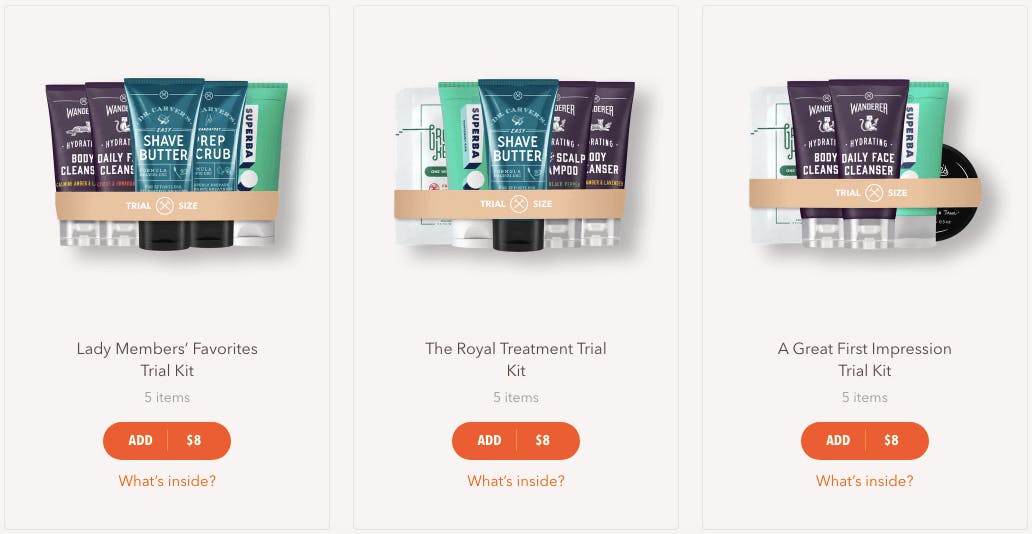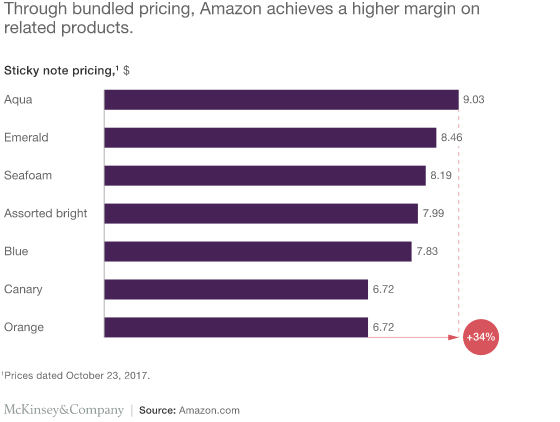Price bundling is a great tool for providing customers with all the functionality they need to find success with your product or service.
Think back to the last time you had fast food or purchased a new phone. You likely didn’t just get a hamburger or a new mobile device—you got fries and a drink or a case and a wireless charger. That’s price bundling.
When consumers purchase complementary products together, whether it’s a set package or a choose-your-own bundle, it’s easier to see the value those products provide. That’s the great thing about a bundle pricing strategy—not only do customers experience the benefits of a suite of products for a single purchase price, but the company also displays more value.
In today’s article, we’re going to talk through what price bundling is and how it can help your business, and we’ll provide a few bundle pricing examples in practice. When you understand the different products or features your customers need to achieve their goals, and when you bundle them together, you set yourself and your customer up to win.
What is price bundling?
Price bundling (product bundling or product-bundle pricing) is a marketing strategy that combines two or more products to sell them at a lower price than if the same products were sold individually. The bundle pricing technique is popular in retail and eCommerce as it offers more value for the price. It can also help build customer loyalty and boost product sales.
Price bundling can be applied to any type of product, but it works best when there are two or more items in the bundle. For example, say you own an ice cream shop and want to offer customers deals on their favorite flavors. You could offer a bundle of three ice cream cones for $4 instead of selling them each at $1 each.
Common bundle pricing examples
Bundle pricing examples can be seen in many industries. The strategy is used to entice potential customers to purchase additional products or services that companies know will be valuable. You’ve likely seen the following real-life bundle pricing examples:
- Mobile devices sold with a data plan
- Microsoft Office 365 and G Suite
- Soup, salad, and breadsticks
In each of these bundle pricing examples, the customer is able to purchase everything they need at a single price, whether it’s software tools or dinner. The company selling these products provides more value in a single purchase than if each item in the product bundle were purchased separately. Think about it: your phone would be less useful without a data plan, and breadsticks really tie a meal together.
We’ve even seen successful subscription ecommerce retailers like Dollar Shave Club implement this bundle pricing strategy for their own products.

Bundle pricing example from Dollar Shave Club
When is a price bundling strategy right for your business?
Bundle pricing strategy is great to use when you have a suite of products or services to offer, or when you want to increase the value of low-volume items. Selling these complementary products together gives customers the functionality they need to get the most value out of your service or product. Bundle pricing strategy makes customers’ purchase experiences better and can lead to more engaged customers over time.
Your product has necessary integrations
In today’s interconnected SaaS and subscription market, certain types of services are built on top of existing functionality to increase value or facilitate integration. When your product requires these types of connections to function properly, price bundling makes it easy to provide every new customer with the functionality they need in a single purchase. There are lots of bundle pricing examples of this in subscription billing platforms, which bundle subscription management with additional features, such as payment gateways, analytics, and revenue recognition.
You need to offer discounts for certain products
Whether it’s a new competitor that’s eating up your customer base or it’s a lack of engagement from existing users, there are times when offering a discount is a necessary part of doing business. While actively discounting products can chip away at their perceived value, price bundling helps you offset these negative effects by combing discounted products together. This helps you capture more revenue for each individual purchase and increases the value add for the customer.
When you’re considering price bundling, it’s important to understand how customers derive value from every part of your business. If you bring together products that don’t increase in value as a bundle, it could drive down sales.
Two types of price bundling
Price bundling falls into two broad categories: pure bundling and mixed bundling. Within pure bundling, there are two subcategories based on how customers get value from different products or features.
Pure bundling
Pure bundling takes place when a customer only has the choice to purchase the bundle as-is or not at all. This type of price bundling is simplest to accomplish, because the creation of a bundle is entirely controlled by you. Joint bundling and leader bundling look at the different features in your bundle and how they work together.
- Joint bundling:
Joint bundling is the process of offering two or more products together for a single price. The products can be obtained only through a single purchase. G Suite is an example of this because you don’t have the ability to purchase Gmail or Sheets as a stand-alone product. - Leader bundling:
Similar to joint bundling, leader bundling is the process of offering two or more products together for a single price. The difference is that, in this bundle, one product is inherently more valuable and is therefore referred to as a “leader” product.
Mixed bundling
Mixed bundling isn’t as strict as pure bundling. When you create a mixed bundle, you’re giving customers the option to purchase each feature together, or individually for a higher price. Microsoft Office 365 offers mixed bundles as well as the ability to purchase stand-alone instances of either Excel or PowerPoint.
Advantages of bundle pricing
Price bundling helps you overcome the difficulty of getting potential customers to make a purchase of specific products or services. It simplifies their buying experience and can potentially increase average order values through the combination of high-value and low-value products.
Simplify the buying experience
When you offer a bundle of normally separated products or features that, together, your customers need to accomplish their goals, you make the purchase decision easier. Instead of expecting them to cobble together different products or features, you’re offering a one-stop shop for them. That makes the experience of interacting with your business and purchasing your product simple and efficient.
Increase sales
Bundling is a great way to increase your sales and profit margins as well as the value you provide to customers. We see this in companies like Amazon, which often create dynamic product bundles based on complementary products their customers typically purchase. This allows Amazon to create larger margins for themselves while also offering a lower price than their competitors.
Let’s take a look at an example with sticky notes of different colors. When a customer purchases orange sticky notes for $6.72, Amazon can bundle those together with aqua sticky notes for $9.03.

Impact of price bundling on margins via McKinsey
This results in a 34% markup from the customer’s intended purpose, helping Amazon tap into more revenue through the bundle while still offering a low price for orange sticky notes.
With a bundle pricing strategy, you’re not just putting together products that complement one another from a business perspective; you’re also giving customers more value through the bundle than they would receive from each individual purchase. That compounding value makes customers more loyal and can lead to future purchases.
Move lower-volume products
If you have a product or feature that’s underperforming, price bundling helps you boost customer engagement by selling it alongside a more popular one. Just make sure that both of the products you’re bundling together increase in value as a result of the bundle. You don’t want to decrease the value of a more popular product or feature by connecting it with one that your customers don’t actually need.
Disadvantages of bundle pricing
The benefits of price bundling outweigh the disadvantages, but it’s still important to understand how a bundle pricing strategy affects your customers. If you’re not careful, you may actually be decreasing the value of certain products or services by bundling them together with others that aren’t as useful for potential customers.
Customers may prefer to buy separately
There will always be customers who want to make their own decisions. When you bundle different products or services together, you’re taking the element of choice away. Doing so can potentially have a negative effect on the customer experience if you’re working in an industry where customers have more purchasing power. Consider how the bundle you’re creating adds value not only for your business but for your customers as well.
Customers may not need all the bundled products
A solid bundle price strategy is predicated on how much value you’re adding for the customer, for the specific products or features, and for your business. It’s important to make sure that you’re always fulfilling an actual need of your target buyer personas. Customers who don’t need certain features will feel like they’re unnecessarily paying for something and will seek out other options.
Price bundling helps you provide more value to customers
When you bundle the right features or products together, you not only make it easier for customers to make a purchase but also give them more value for a single purchase than if they were to buy individual products. That creates a more engaged and loyal customers base that’s primed to make an additional purchase down the line.
If you need help creating your bundles, Price Intelligently's tools and expert pricing strategists will help you identify which products or features are the most ideal for bundling. They will help you determine the optimal price for any bundle and will share best practices for how to use bundling to grow your business.
Price Bundling FAQs
What are price bundling examples?
When price bundling, companies will sell two products together at a lower price than the sum of the individual price of each product. Common bundle pricing examples are cable TV and mobile plans and fast food restaurant value meal combos.
What's the benefit of price bundling?
Price bundling offers customers a bigger perceived value per purchase. Offering customers package deals is a good way to build goodwill when they purchase a new product.
How do I decide which products to bundle?
Deciding which products to bundle depends on how well the two products work together. Typically, brands will bundle products that are complementary or related to each other so that customers will feel like they are getting a deal when purchasing a bundle.
Why is bundle pricing strategy good for your revenue?
Price bundling is a good revenue strategy because it increases your net sales upfront by simplifying the buying experience for your customer. By bundling relevant products as a package, you are positioning your product to offer more value per purchase to your customer and building brand loyalty through product adoption.



